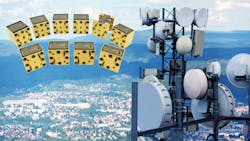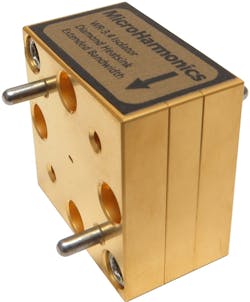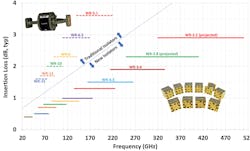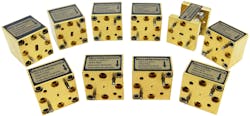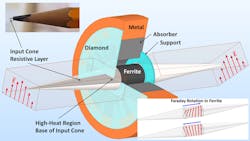5 Critical Features of mmWave Isolators for Higher Wave-Spectrum Frequencies
Satisfying the inexhaustible future demand for wireless spectrum will mean taking advantage of the higher ends of the electromagnetic (EM) spectrum. Driven by 5G, 6G, and beyond; ultra-high definition video; autonomous vehicles; security applications; and IoT, designers must capitalize on the millimeter-wave (mmWave) bands, which presently cover 30 to 500 GHz, to fill spectrum requirements.
However, these higher frequencies present a significant problem that design engineers must address: standing waves. Without remediation, these unwanted waves can attenuate power output, distort the digital information on the carrier, and, in extreme cases, damage internal components (Fig. 1).
To counteract the problem of standing waves at lower microwave frequencies, engineers rely on Faraday rotation isolators—more commonly referred to simply as isolators. At their most basic level, an isolator is a two-port (input and output) component that allows EM signals to pass in one direction but absorbs them in the opposite direction (Fig. 2). However, traditional isolators fall short at the higher frequencies required for next-generation wireless applications.
A big part of the problem is that the first isolators were designed over 50 years ago, with very few modifications since the original concept (Fig. 3). With recent advances, however, companies at the cutting edge of mmWave technologies are gaining the ability to launch products that operate optimally at stratospheric frequencies.
By understanding these advances in each of the five properties of isolator functionality, designers can better harness isolators to improve their mmWave products:
1. High isolation
Isolation is a measure of how much of the signal traveling in the reverse direction passes back through the isolator. Because isolators are intended to prevent or minimize this from happening, the higher the isolation, the better.
The issue that mmWave system designers face is impedance mismatches and the resulting reflections between components. In mmWave systems, the distance between components is often more than a wavelength, putting reflected signals out of phase. This can perturb the operating point of the upstream component. As you sweep frequencies, the phase changes and you get nulls, dips, and degraded performance. However, when you insert an isolator between components, the reflected signal gets absorbed and the problem is resolved.
The highest possible isolation occurs when the reverse wave is rotated exactly 45 degrees into the plane of the isolator’s resistive layer. Isolation can degrade by as much as 10 dB when the signal rotation is off by just 1 degree. The only way to confirm such precision is to fully characterize each isolator on a vector network analyzer. This validates total compliance, as opposed to just spot-checking at a couple of frequencies in the band.
2. Low insertion loss
While isolation is the namesake of these components, the suppression of the reverse wave can’t come at the expense of attenuating the forward, input signal. Insertion loss is a measure of how much loss a signal incurs as it passes through the isolator in the forward direction.
For traditional-style isolators, insertion loss is low in the microwave bands. However, at mmWave frequencies, the loss becomes increasingly problematic. For instance, in the WR-10 band (75 to 110 GHz), the insertion loss can exceed 3 dB, meaning half of the signal power is lost. In the WR-5.1 band (140 to 220 GHz), the loss climbs to more than 5 dB. Because of such high losses, traditional isolators are often precluded for use in mmWave systems.
One of the biggest fears for any designer is that the isolator will significantly degrade the strength of the final output. It can be frustrating for engineers to try and tune the standing waves out of each system, usually with limited success. Many of the alternate methods used are narrowband in nature, so that the solution may work well only over an insufficiently narrow band of frequencies.
Faraday rotation isolators operate by using ferrite discs to rotate the signal. However, the traditional method to manufacture them has been to use ferrites that are substantially longer than the minimum required length, and then tune the magnetic bias field to achieve optimal performance. This delivers good isolation, but at a much higher insertion loss.
This workaround presents a two-fold problem. First, there’s more of the lossy ferrite in the signal path, and second, the ferrite loss parameter increases at lower magnetization levels.
To minimize loss, it’s essential that the ferrite length be reduced as much as possible. The biggest improvement in the latest designs developed for NASA saturates the ferrite with a strong magnetic bias field, which allows for the shortest possible length of ferrite to achieve the ideal 45 degrees of rotation (Fig. 4). This lowers the insertion loss to less than 1 dB at 75 to 110 GHz and only 2 dB at 220 to 330 GHz.
3. Low port reflection
A good isolator must also have low port reflections. Voltage standing-wave ratio (VSWR) is a measure of the reflections at the input and output ports. A good range at mmWave frequencies is 1.5:1 or less; 1:1 equals no reflection.
The importance of low port reflections is often overlooked. An isolator with high port reflections creates an alternate set of standing waves. The adjacent components are still adversely impacted by out-of-phase signals reflected into their ports. High isolation and low insertion loss are of little value if the port reflections are large.
4. High power rating
Power in the reverse traveling signal is absorbed in the isolator, resulting in heat. The more heat it can handle, the higher the power rating. Historically, high heat wasn’t an issue as there was very little power available at mmWave frequencies. However, as higher power sources become available, power ratings become more important.
To handle the problem of high heat loads, some newer isolators are already incorporating diamond heatsinks into their design. Diamond is the ultimate thermal conductor, approaching 2200 W/m•K (watts per meter-Kelvin), more than five times higher than copper. Diamond effectively channels heat from the resistive layer in the isolator to the metal waveguide block, and thus lowers operating temperatures for improved reliability.
5. Small footprint
Minimizing the size and weight of mmWave components is especially important in today’s wireless applications. A standard traditional-style isolator in the WR-10 band is about 3 inches long, with a cylindrical section in the center that’s approximately 1.3 inches in diameter. However, the newest design shapes are rectangular and can be as small as 0.75 inches per side and 0.45 inches thick.
The same technology used to reduce insertion loss—utilizing the shortest possible length of ferrite—also partially accounts for the reduction in footprint (Fig. 5).
In addition to the five critical characteristics, other properties of modern isolators improve their utility at mmWave frequencies, such as wide bandwidth. Standard waveguide bands typically extend to 40% on either side of the center frequency. Newer, high-performing isolators operate over extended bandwidths exceeding 50% from center frequency, giving designers greater freedom to build more bandwidth into their systems.
Additional advances include isolators that operate in cryogenic conditions. This is a critical characteristic, because a traditional isolator designed for room-temperature operation will perform poorly when cooled.
David Porterfield is Founder and CEO of Micro Harmonics Corp. (MHC).
About the Author
David Porterfield
Founder and CEO, Micro Harmonics Corp. (MHC)
David Porterfield has over 30 years of experience designing millimeter-wave (mmWave) components and systems. He has a Ph.D. in electric engineering from the University of Virginia and is currently the CEO/CTO at Micro Harmonics Corporation. Porterfield’s areas of expertise include microwave and mmWave component and system design, high-frequency linear and nonlinear electromagnetic simulation and design, GaAs diode technology, as well as ferrite component design, and has authored over 30 technical papers.
